I think everyone is familiar with the images of the Medieval time witches flying on a broomstick or the witches making magical potions by stirring some awful looking substances in a boiling cauldron….these images are associated with Halloween nowadays… but, to your surprise (as well as mine), some of the brews these witches made were the precursors of some of the major drugs of today.
Traditional Chinese medicine gave the world ephedrine for asthma. The Quechua people of Peru gave western medicine quinine for malaria. So, it shouldn’t come as a surprise that the strange brews of weird sisters in the Middle Ages were not total hocus pocus or just simply crap.
Perhaps the most striking example of witchcraft’s influence on medicine comes from psychotropic plant compounds associated with “flying ointments,” salves reportedly created as magical aids during the height of the European witch-hunting craze in the 1500s and 1600s.
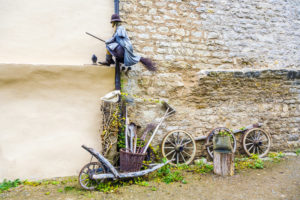
Some of these plants prove poisonous at high doses, but some also contain a tropane alkaloid called hyoscine. Native Americans used a hyoscine-rich plant called thorn apple (Datura stramonium) as a local anesthetic, but also in religious rituals, because at higher doses hyoscine can cause delirium and hallucinations. In medieval Europe, hyoscine’s association with magic may explain the link between witches and broomsticks.
Supposedly witches applied the salve to their skin—either under the arms or (for the daring) on the genitalia. Absorbing the chemicals through sweat ducts avoids the stomach, the vomiting (which is a natural reflex of trying to rid of body of noxious substances) and risk of poisoning. Hallucination and the altered mental state induced by hyoscine may have given medieval witches the illusion of flight. It’s unclear how widespread these flying ointments were, though, and some question the veracity of such claims, since prosecutors of that time may have coerced the confessions, which was a very common practice of those days.
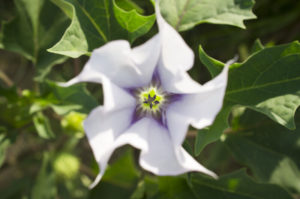
Datura stramonium (Jimsonweed or Devil’s snare)
Today hyoscine—also called scopolamine in the U.S.—is a common treatment for motion sickness, as low doses can relieve nausea and stomach cramps.
The ointment herbs henbane (Hyoscyamus niger), deadly nightshade (Atropa belladonna) and mandrake (Mandragora officinarum) also contain other tropane alkaloids. From nightshade, 19th-century chemists isolated atropine—a muscle relaxant that was later used to calm patients during surgery before the administration of anesthesia. Atropine also remains the go-to antidote for nerve gas poisoning. We are all more familiar with atropine sulfate eye drops when we go to an ophthalmologist, as it is used to dilate the pupil before eye exams. Tropane alkaloids continued to prove useful as chemical backbones in 20th-century drug design, most notably producing the anti-psychotic drug haloperidol.
A side and weird note for mandrake. Its roots can look bizarrely like a human body, and legend holds that it can even come in male and female form. It’s said to spring from the dripping fat and blood and semen of a hanged man. Legend has it that if you dare uproot a mandrake, a scream will be heard and the individual will die in agony and madness….so how did they uproot one back then? They would tie a dog’s tail to the plant and plugged their ears with wax…and I am sure no dog died in these proceedings…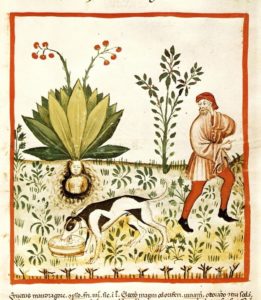
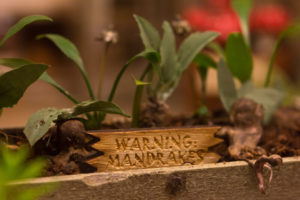
Mandrake (Mayapple)
Many of the women and men tried as witches in Europe during the late Middle Ages and the Renaissance practiced midwifery or medicine. Doctors were scarce, and for members of Europe’s lower classes, local healers were often the only option. When medicine started to be regulated around 1200, women were barred from formal medical training at universities, and those that continued as physicians or midwives were sometimes labeled witches. A few were even tried for illegally practicing medicine.
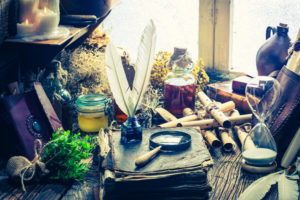
While most of the potions and ointments intended as cures might have been pretty ineffective, a few ingredients lining a witch’s medicine cabinet probably exist in yours in some form. Willow bark would have been used to treat inflammation, because we now know it contains salicin, a compound that eventually gave rise to salicylic acid and later aspirin. Garlic was used to treat a variety of maladies from snakebites to ulcers, and today some garlic compounds have been marketed as blood clotting inhibitors.
Foxglove plants were also in the mix. Seventeenth century herbalist Nicolas Culpepper recommended it for epilepsy. But it’s a Scottish doctor named William Withering who is credited with pioneering the use of the plants’ extracts for heart problems. In 1775, a patient with “dropsy”—a term for swelling, probably caused by heart disease—came to Withering’s Birmingham practice. No treatment seemed to work, so the patient sought a second opinion from a local Gypsy woman. She prescribed a potion containing an estimated 20 different plant ingredients, and he was cured.
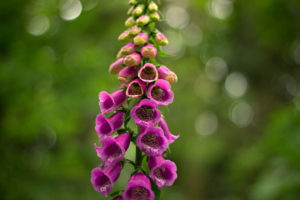
Digitalis purpurea (Foxglove or Witch’s glove)
Keen to learn its properties, Withering tracked down the healer and figured out that the active ingredient in her potion was purple foxglove (Digitalis purpurea). He then performed a clinical trial of sorts, testing different doses and formulations on 163 patients. Withering ultimately determined that drying and grinding up the leaves produced the best results in small doses. Digitalis plants gave us the modern heart failure drugs digoxin and digitoxin.
So, it was not all hocus pocus. Some of these witches’ brews helped, to some degree, bring modern drugs to market and ushered the transition from medieval medicine to modern medicine.
